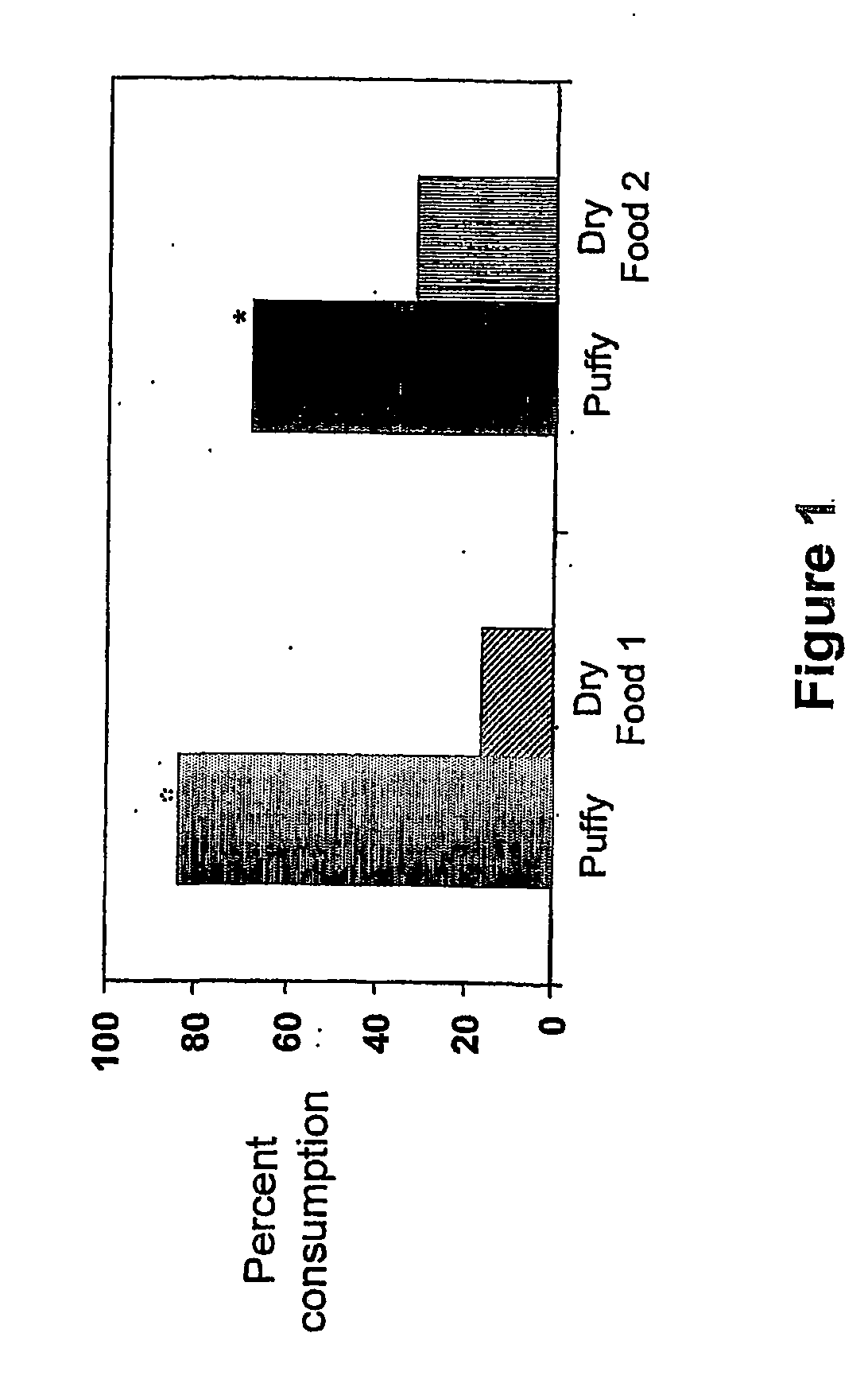Puffed pet food for diet control
a pet food and diet technology, applied in the field of pet food products, can solve the problems of increased feces production, less palatable food, and continued weight gain of pets consuming this type of food products, and achieve the effects of reducing calorie intake, reducing body fat, and reducing body fa
- Summary
- Abstract
- Description
- Claims
- Application Information
AI Technical Summary
Benefits of technology
Problems solved by technology
Method used
Image
Examples
example 1
Highly Expanded Dry Pet Food I
[0038] A dry mix is prepared from about 24% by weight of whole corn flour, about 20% by weight of corn gluten, about 10% by weight of rice flour, about 18% by weight of high amylose corn starch (amylose to amylopectin ratio of 50:50), about 5% by weight of maltodextrin, about 20% by weight of poultry meal, about 5% by weight of fish meal, and about 6% by weigh of various vitamins and minerals. The dry mix is fed into a preconditioner along with a flavor digest. The preconditioned mixture is then fed into an extruder. The preconditioner is operated at about 190° F. Steam is injected into the preconditioner at about 1.2 kg / minute and water at about 0.6 kg / minute.
[0039] The moistened feed leaving the preconditioner is then fed into an extruder. The screw configuration and screw speed are adjusted to 650 rpm, to provide an SME (specific mechanical energy—kWhr / kg) of 0.01-0.1, which is at the upper end of the extruder capabilities and is significantly more...
example 2
Highly Expanded Dry Pet Food II
[0042] A dry mix is prepared from about 24% by weight of whole corn flour, about 20% by weight of corn gluten, about 5% by weight of high amylose corn starch (amylose to amylopectin ratio of 50:50), about 5% by weight of maltodextrin, about 10% by weight of tapioca, about 5% by weight of wheat starch, about 20% by weight of poultry meal, about 5% by weight of fish meal, and about 6% by weigh of various vitamins and minerals. The dry mix is fed into a preconditioner along with a flavor digest, as in Example 1. The moistened feed leaving the preconditioner is then extruded as in Example 1, except that the rpm was reduced to 550. Also, because some of the ingredients were pre-cooked, the temperature in the extruder barrel was reduced somewhat. The pieces are then coated with flavoring agents and dried in the normal manner. Illustrative flavoring agents include 5-15% tallow, 5-15% syrup, and 1-10% chicken digest However, it is understood that other flavor...
example 3
Animal Palatability Tests
[0044] Because of their unique ingredients and processing steps, the puffed products differ from the standard kibble in a number of different sensory and physical dimensions. For example, with the pet:food formulation of Example 2, the product is crunchier than the standard pet food. A number of palatability trials were run to assess the palatability of puffed products (different coatings were assessed) for both dogs and cats.
[0045] Dogs significantly preferred the puffed product of Example 2 over two popular brands of regular dry pet food (FIG. 1). Overall food consumption was not compromised during the trials and no animals were flagged for low consumption.
[0046] In the cat preliminary trials, results from 23 paired trials using a puffed product according to Example 2 versus Friskies® Ocean Fish (FOF) showed parity for the puffed products and FOF, in terms of percent consumption. In later trials, when modifications were made to the product, significant ...
PUM
 Login to View More
Login to View More Abstract
Description
Claims
Application Information
 Login to View More
Login to View More - R&D
- Intellectual Property
- Life Sciences
- Materials
- Tech Scout
- Unparalleled Data Quality
- Higher Quality Content
- 60% Fewer Hallucinations
Browse by: Latest US Patents, China's latest patents, Technical Efficacy Thesaurus, Application Domain, Technology Topic, Popular Technical Reports.
© 2025 PatSnap. All rights reserved.Legal|Privacy policy|Modern Slavery Act Transparency Statement|Sitemap|About US| Contact US: help@patsnap.com


